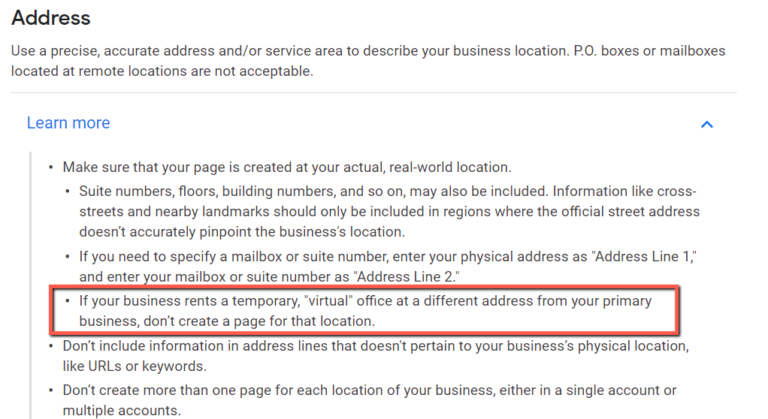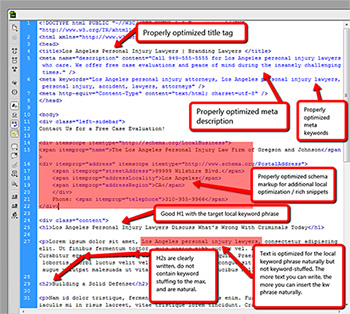There are many ways to optimize your website for local search so you can be found for multiple locations.
Just as there are many ways to optimize, so there are a variety of penalties lurking if you follow bad practices that egregiously violate Google’s guidelines.
By keeping a thorough inventory of your local SEO efforts, you will be able to avoid duplication and ensure high-quality implementation of all local SEO for your clients.
In addition, by learning the ins and outs of local SEO, you will be able to help yourself by creating your own winning strategy, rather than copying your competition and hoping you don’t get penalized by shady SEO tactics.
What Does Local SEO Look Like Today?
It should go without saying that legitimate businesses are more likely to have a chance to rank in Google local search as opposed to businesses that are less than legitimate.
This means a business with a winning product or service. Something so compelling and that helps the user accomplish what they are looking for, which matches the intent behind their query.
Don’t engage in any tactics that would be considered foul play: things like buying fake likes or reviews. Also, fake comments.
These will not help your business and in fact, could lead to major issues with your SERP performance down the line.
Likely, local SEO will continue to be focused on citations as links, great-quality local content, and achieving sufficiently-amplified traction across local news and media.
Although new factors could eventually be implemented including entity-based local algorithm adjustments, and voice search playing a part (although this is still up for debate).
Near me searches have also increased recently, so it will be important to focus your local strategy on optimizing for “near me” queries.
Accuracy in Your Business Listings Is Also Important
Make sure all of your business listings match up with the NAP citations on your own site – punctuation, exact appearance, etc.
All of this plays a part in ensuring the accuracy of your business listing.
If something’s off, there could be difficulties locating your business, and in the algorithm’s interpretations of your on-site local SEO.
In other words, it could cause some confusion regarding where your business is really located.
Don’t Use ‘Virtual Office’ Locations
Common technique for local SEO in service industries includes using virtual office locations, where the business will buy a virtual office, rent it, and implement it in their local SEO Google My Business listings.
Google recently made a GMB guideline clearer about the legalities of virtual offices as they relate to Google’s terms – and the news is not great.
I myself have had clients in the past who have been wiped off of Google Maps for ignoring this guideline because quite simply, their competitor likely outed them in a spam report.
This little-known guideline for GMB says that you should not use Virtual Office locations as part of your strategy.
The only time you can use an off-site location is if it is fully-staffed during business hours.
This can have serious, negative consequences for your site, including and up to complete removal of your GMB listing if you are found out:

If this is a significant part of your Google My Business optimization strategy, you need to get rid of this now before you suffer consequences (if you are not suffering consequences for breaking this rule already).
Make Sure Your Business Shows Up in the Knowledge Panel
Local structured data is important to achieving a knowledge panel about your business in the SERPs.
Make sure:
- This structured data is added properly.
- That it validates in Google’s Structured Data Testing Tool.
- That there are no issues when it is indexed.
Here are some guidelines for implementing local SEO Schema: How to Use Schema for Local SEO.
It will be very awkward if your business listing shows up with punctuation errors on Google when due diligence was not properly performed in the first place.
Assessing Your Competition & the Market
 Performing the proper competitor research on local content and links will help you determine how you will attack a particular niche.
Performing the proper competitor research on local content and links will help you determine how you will attack a particular niche.
First off, let’s examine a niche that is all-too-often overlooked: personal injury lawyers.
Say we are putting together a local campaign that will eventually target the top cities in the states.
We need to assess the general market and target markets that will fit our budget.
If we have a $1 million+ budget, it makes sense to go after the larger markets like Los Angeles, San Diego, etc.
But, if our budget is smaller, we will not be able to go after some of the larger markets.
Assessing the market is important before assessing the local competition.
You are assessing its ease of ranking, as well as other factors including traffic.
Now, while I can’t cover every single type of site in existence, I am going to dive into factors to consider at the start of your local SEO campaign.
Perform Your Research at the Population vs. Dollar Budget Level
Every city is going to have its own population numbers, its own population characteristics, and its own buying cycles.
It is important to assess the population and size of the market for two reasons:
- Budget: You do not want to throw money away selling motorcycles to a market largely interested in sweaters.
- Identify trends so you can time your campaigns around these increased buying periods.
Assess Your Competition
In any local market, you’re going to have local companies competing with each other who offer the same products and services.
When you assess your competition, you are assessing the ease of ranking for a particular market.
When you examine your competition, it is important to look at their:
- Linking strategy.
- Content strategy.
- Website structure.
Linking Strategy
When it comes to a local SEO linking strategy, it is important that you embark on a strategy that is highly specific and locally targeted to your city.
Ranking in local is very different from ranking in organic search: ranking factors are dependent on how strong the signals on your site are for your business’ specific location.
This is where local directories come in handy: they can help you get links for your locations fairly quickly without much effort.
Other types of local links include links in the local newspaper’s website, links from any website in which the URL has your city name in it, and links from your local chamber of commerce.
It is critical to assess the quality of the website linking to you before you go after it to avoid issues down the road.
Your local linking campaign is all for naught unless you get a handle on Google’s quality guidelines to ensure your links are not in violation of guidelines.
It is essential to go for top quality links if you want your local SEO campaign to show results.
In addition to all of the above, you need to consider how your competition is building links to their website.
Using several tools, you can assess what links your competition is going after on nearly a daily basis.
Content Strategy
In addition to linking strategy, on-page optimization is crucial.
When creating local content, you want to make sure your content is locally focused and highly optimized towards the local areas you are targeting.
For example, if you were targeting “los angeles personal injury lawyers” you would need to ensure your URL, title tags, meta description, meta keywords, H1s, H2s, content, and internal links, are optimized surrounding this keyword phrase.
If you want to get hyper-local, using a geolocation tag is important as well.
This is incredibly important when optimizing for your local on-site signals: do not forget to include the address of the location of your business on-page in text form.
This means: not in a graphic, not in a video, but in text form only.
Although Google crawls images, do you want to take the random chance that Google is not going to read that local ranking signal properly because you did not optimize it properly?
 And yes, I know you are all rolling your eyes at the “meta keywords” thing, but hear me out: there is a reason why I mention this.
And yes, I know you are all rolling your eyes at the “meta keywords” thing, but hear me out: there is a reason why I mention this.
Yes, Google and Yahoo have both stated that they do not use meta keywords for rankings.
Duane Forrester, former Senior Product Manager at Bing, stated this in the past:
“I’ll make this statement: meta keywords is a signal. One of roughly a thousand we analyze. Getting it right is a nice perk for us, but won’t rock your world. Abusing meta keywords can hurt you.”
Because of this, and the fact all search engines do things just a little bit differently, it is OK to at least populate some keywords into the meta keywords tag, but don’t go overboard to the point that you reveal your entire keyword strategy to your competitors.
Or, even worse, you end up being flagged as spam by improper use of this tag.
Because the search engines do not use it for ranking, don’t waste a tone of time here.
At best, spend a few minutes putting in some keywords.
Put in a few well-researched, targeted keyword phrases, but don’t spend a lot of time on the meta keywords tag. Proceed accordingly and with much caution.
What Does a Properly Optimized Local Page Look Like?
Let’s take a look at the structure of a page that has properly been optimized for local on-page SEO:

Properly Optimized Title Tag
This should be optimized to 50-60 characters in length, or you can take the newer approach of optimizing your title tag according to its pixel width.
Like the meta description below, the title tag should include the targeted location keyword phrase, the title of the page / article, and branding.
Ideally, a properly optimized title tag structure for most sites can look like:
Local keyword phrase in front | Title of Article | Company Name
Properly Optimized Meta Description
This should be optimized to approximately 156 characters.
The important thing is to make sure that you include your targeted location keyword phrase in the meta description.
While this will not improve rankings, it is an indirect improvement through having another point of relevance in your document, and reinforces your targeted keyword use.
In addition, you can also include a local phone number as another local signal (note: local signal, not ranking signal) in addition to including a point of conversion.
There are a number of people who will call your page directly from the search results because it is fully convenient to do so from a mobile device.
Properly Optimized Schema Markup for Local Optimization or Rich Snippets
Surprise! Schema.org markup is important for better local SEO – but it is not a ranking factor.
It will allow you to appear in the rich snippet results of the Google search results for your business location – which is another way of getting your site “up there”.
But, make no mistake – it is not a local ranking factor, just another avenue for ensuring that your site appears near the top results on the SERPs.
Good H1 with Targeted Local Keyword Phrase
A high-quality H1 header tag with your targeted local keyword phrase is necessary for local on-page optimization.
There are no real character lengths for this one.
Just make sure it is short, catchy (for drawing those pesky things called readers into your article – you do remember those people right?), and includes your targeted local keyword phrase in such a way that it does not appear spammy to those aforementioned humans.
Optimize Actual Article Text for Your Local Keyword Phrase Naturally
Remember the days of 2002 in SEO, when keyword-stuffing was the hot SEO technique of the day?
Unreadable articles with keyword phrases stuffed in every other word plagued the web until Google rolled out its Florida update in 2003.
While it is important to optimize for specific keyword phrases in general organic SEO, on the flip side, it is also important to optimize for the local keyword phrase for local SEO.
When you have multiple pages dedicated to multiple locations, you need to change your focus of those pages to suit those locations.
For example: if you are performing optimization for one location like “Orange County personal injury lawyers,” then you will want to make sure that your page is optimized for Orange County personal injury lawyers.
If you are optimizing for Long Beach personal injury lawyers as another location, the page should be optimized for Long Beach personal injury lawyers.
Change Your Local Content to be Substantially Unique From Page to Page
It should go without saying that even though you are optimizing for different locations, you should not use the same content from page to page in order to optimize for each location properly.
Google’s Panda update has put a stop to all of that.
You must create quality content for each page that is being optimized for a different location to be successful.
I like to refer to it as “The Lazy SEO’s Way of Local SEO.”
They don’t want to put in the effort to write quality content, so they simply use the same content from page to page and change the location-specific parts, thinking that they will only get people from those locations on that page.
While, to some extent that is true, it is not always the case.
It is, after all, only fair to take into account other visitors to your site who may visit other pages.
Maybe they are planning a trip and want to visit the other locations?
What if you were a visitor to a site that took this lazy approach and found the same content but only changed from page to page based on locality rather than the quality of the content?
You wouldn’t want to convert or buy from that site now, would you?
You would be thinking: “Why should I buy from a site who isn’t at least interested in their work enough to change their content for my location?”
It should go without saying: change your content strategy to compensate for quality content per locally optimized page.
This way, you avoid future algorithmic or, worse, manual penalties when Google manually views the site and you have to change all of that content anyway.
Consider Increasing the Quality of Your Local Content by Writing Longer Articles
In addition, you should also consider article length.
Longer articles tend to perform better (although this is not always the case – be sure to check your SERPs by using a competitor analysis tool to understand what Google is actually rewarding the top 10 results for.
Longer, more in-depth articles can lead to an overall lesser bounce rate, better reader retention rates, and overall better chances of going viral when they have the correct information written and conveyed to readers.
As a general rule, 400 words is considered an acceptable length for most competitive industries.
Again, this is going to be dictated by what your competition is doing in the search results.
But – and there is always a but – you should always look at other factors of the site to rule out things like quality links benefitting the organic rankings instead of just the content.
While you will never know for sure what’s causing those great rankings (because you will just as likely see a site with a 5,000-word article at #8 and a site with a 2,000-word article at #4), you can get a good idea as to what general range you should target by looking at those competitors in the SERPs.
But, the thing is: a 2,000-word article can trump the success of a 4,000-word article any day if it is more valuable and of higher quality than the 4,000-word article.
You can improve your chances of content success by making sure that:
- Your article is targeted towards readers who care about the topic you are writing about.
- You get the article shared with those who can help you spread the word on the article.
- And, the most important part, that targeted people throughout your location also care about the content you are optimizing for.
All of these issues and more are what you should examine as part of your local SEO content strategy. Let’s recap the dos and don’ts:
- Don’t write bad content from page to page and switch up the local SEO information.
- Don’t keyword-stuff your content.
- Don’t skimp on the quality of your content because you want to be lazy.
- Do make sure that your title tag, Meta description, and meta keywords are properly optimized.
- Do make sure that you optimize text content appropriately.
- Do make sure to write good H2s that don’t include the targeted keyword phrase and make them catchy, punchy, and interesting enough to draw readers into sections of your content.
- Do make sure that you include schema markup if your local SEO plan includes optimization for rich snippets.
Optimizing for Local SEO Off-Site Signals
First of all, it is still important to perform a local SEO audit of all existing off-site signals.
When you perform this kind of an audit, you can assess whether or not your current local SEO is good enough to move forward from or if it needs a complete overhaul.
If it needs a complete overhaul, you will need to spend some time cleaning many things up in order to get your local SEO performing properly and meeting expectations.
Address Bad Reviews & Negative Online Sentiment
While Google maintains that E-A-T is not part of their algorithm, the Google Quality Raters Guidelines discuss E-A-T in-depth as something their manual website raters must rate when they review a site.
E-A-T stands for Expertise, Authoritativeness, and Trustworthiness.
Many local SEO link signals, citation factors, and online sentiment play into trustworthiness.
While we don’t suggest following everything in Google’s QRG due to its unproven nature, it does make sense to ensure your local signals are at as high a quality level as possible during implementation.
In other words – make sure all of your links follow Google’s Webmaster Guidelines and are not obvious spam or unnatural.
This means that local authority sites are important – and local directories should be a small focus of your link strategy. Don’t go after junk links (just like white hat link acquisition), etc.
Instead, create great local content that qualifies as link magnets and which is conducive to building that critical local authority, expertise, and trust.
This is a very broad area, but this article should help you get a handle on where to start. Apply the attributes in that article to the creation of your own local-focused content.
Bad reviews and negative online sentiment play into this greatly.
Cleaning up any negative reviews by making sure you are responding to clients and resolving their concerns is a great first step.
But, you don’t want to outright go after removing them unless the reviews themselves lack a factual basis or are dishonest.
Instead, a better strategy to deploy is to address negative reviews and implement better company processes to make sure they do not happen again.
Then, as people begin giving your company better, and higher-rated reviews, this can play into your positive online sentiment.
Google does say that more specific things like physically having a BBB profile does not help, and is not something they use in their algorithms.
The Audit: What Should You be Looking For? And How Should You Strategize?
 When you begin a local SEO audit, you are making several assumptions: that the off-site signals are not perfect, and that you will be moving forward with a plan to fix them after the audit.
When you begin a local SEO audit, you are making several assumptions: that the off-site signals are not perfect, and that you will be moving forward with a plan to fix them after the audit.
When you first examine your off-site signals, you will need to start with the business’ contact information.
This will usually require a meeting with the partners in charge in order to find out what the exact, correct business name and locale information is.
See, in a perfect world, we will all want to have a website that is exclusively our own with no one else’s fingers in the pie. All information is correct, and everything is fine and dandy.
However, business life seldom works out that way.
You have different people at different times who have their fingers on the website.
You have different organizational structures, organizational re-orgs, people get fired, people get laid off, and people leave the company for other reasons.
In the shuffle, things can happen that cause off-site signals to get completely messed up and otherwise FUBAR.
It’s not always the fault of the person or marketing agency in charge of the websites, but when it comes to the marketing agency who has to clean up all of the issues that plague local SEO on these sites, we need to perform an audit.
Audit the Appearance of Off-Site Local SEO Information Across the Main Money Profiles
These main money profiles include Google Local, Bing Local, and Yahoo Local.
After this main money priority is completed, then move forward with checking the lesser profiles.
Audit Whether or Not You Have Claimed All Essential Local SEO Profiles
Using a program like Brightlocal or Whitespark, you can audit all of your existing local SEO profiles.
It will be important to build spreadsheet data that charts all instances of every single address in every single profile.
Why is this important?
It is important because variations in data can cause major issues with getting your site ranked in the local results as high as it can be.
It can come down to having a difference between Suite, Ste., and #, a difference between St. and Street, and a difference between Ave. and Avenue. So, an address like:
Some Marketing Agency
9000 West Something Street
Newport Beach, California
92660
Is completely different when written like this when it comes to the eyes of Google Local SEO:
Some Marketing Agency
9000 W. Something St.
Newport Beach, CA
92660
Can you spot the differences?
It is so important to make sure that the address on your website matches all instances of addresses in your off-site local profiles.
Otherwise, the local SEO signals get very messy and this can interfere with your local rankings in a major way.
Prioritize Your Strategy to Go After the Larger Money Profiles & Claim the Rest of Your Local Profiles
A platform such as Yext can make a huge difference here for efficiency reasons.
You can set up Yext to comb all of your profiles for local information accuracy, as well as submitting your site to many different local profiles quickly and accurately.
Then you can go onto the Google SERPs and find those much lesser sites to obtain local SEO links from.
BrightLocal is also a wonderful dashboard-based system for maintaining your local profiles.
Its ease of use and the fantastic user interface is something to behold as you perform this analysis and claiming those all-important profiles.
Define Your Content & Linking Strategies Based on Your Keyword Audit
 Content and linking strategies can be very different; everyone and their brother promises results.
Content and linking strategies can be very different; everyone and their brother promises results.
The thing is, you can vary the content and linking strategies a ton and get different results.
But how do you know what works best for your niche?
You do this by testing on sites that are different from your main money site.
Now, let’s take an example: we want to define a content and linking strategy for Los Angeles personal injury lawyers as a keyword phrase.
Through various research in the Google top 10 search results, we find that just about everyone has a blog, but the top results are publishing 2,500-word pieces of content per day.
Examining their link profile in Majestic SEO reveals a varied link profile with many different, valuable links coming into play that are very likely helping get their site into the top spots.
So how can we beat this site if we have a lower budget?
We can do this by creating more valuable content.
This is how you can get a 1,500-word piece of content to outrank that 2,500-word piece of content: by making it more valuable.
You make it more valuable by writing higher quality content, content that people will care about, and content that will go viral across various social networks.
Sometimes, just physically writing the 1,500-word piece of content to be better in quality than the 2,500-word piece of content will result in it ranking better.
However, it is rare unless there are plenty of really good quality links behind that specific domain or page (a website like CNN could probably do this because of their website authority alone).
As you define your content and linking strategy, also keep in mind your social media strategy.
Target users who care about the topics you are writing about, and make sure you target influencers that will share your content so you have a chance to go viral.
Building that social media strategy is slightly beyond the scope of this article, but, you get the idea.
And be sure to target local users who will care about and share your local content and get the word out to potential customers of your brand.
Remember, the physicality of actually sharing and amplifying the social reach of content does not help rankings.
It helps builds trust to Google indirectly and therefore your rankings will eventually increase in an indirect fashion.
Social sharing will not, however, increase your rankings directly.
Correlation is not always causation.
You Must Have 100% Correct Local Information on All Local SEO Profiles, Not Just Your Main Money Profiles
If you have performed every possible SEO fix to your website and you are still not getting rankings locally, look at all of your off-site SEO, including local SEO profiles.
Auditing both links, on-site optimization location information, and local SEO profiles will help save you a ton of trouble in the long run and will help prevent you from having to do an audit again (at least not for a long while).
In addition: do not forget to include the local information on your website in text form.
That being said, it is always a good idea to perform local SEO audits of this type at least every six months, if not every 90 days.
This way, you can make sure your local SEO campaign is not heading into the gutter, and that you continue to stay on track until you hit that coveted number one spot in the local results.
Make No Mistake: Local SEO Requires Strategy & Analysis Like Other SEO Tasks
Local SEO can be an incredibly complex endeavor.
This is especially true when multiple locations are involved.
However, by following best practices, keeping in mind Google algorithm updates, sound research, and assessing your strategy accurately, you will be able to obtain high local SEO rankings without causing the next heart-attack-inducing penalty to hit your site.
Following safe measures, content and linking strategy, as well as the Google Webmaster Guidelines themselves will help get you there.
In addition, doing your due diligence will help put you past the competition into the winner’s bracket.
After all, that’s why we’re all doing local SEO right? We are in it to win it.
More Resources:
- Local SEO: The Definitive Guide to Improve Your Local Search Rankings
- 5 Tips to Improve Your Regional SEO Strategy
- SEO Checklist to the Perfect Location Page
Image Credits
All screenshots taken by author




